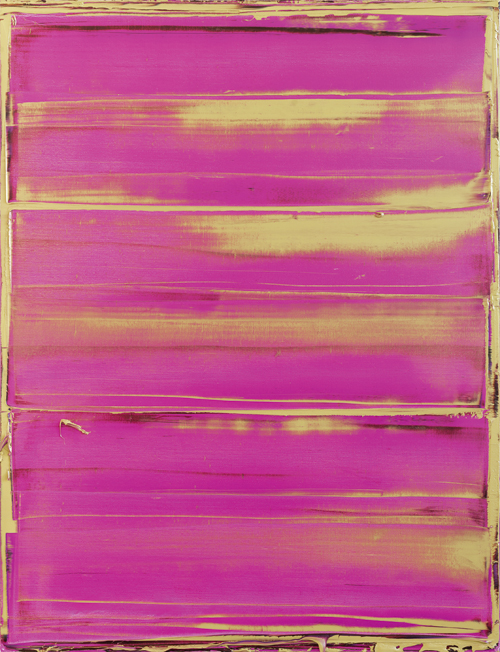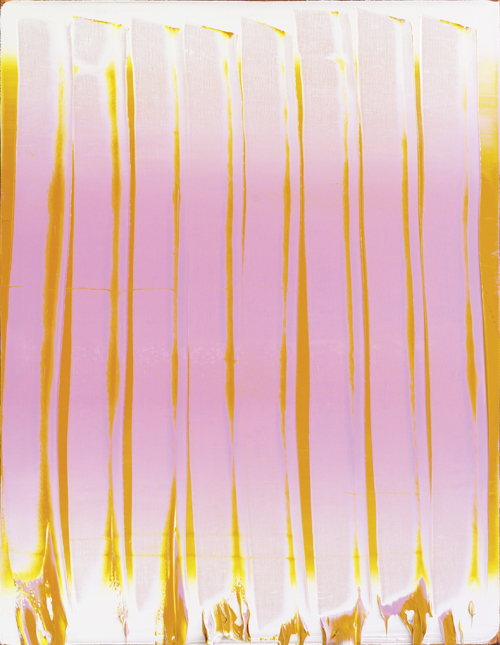Peter Krauskopf
Künstlerhaus Bethanien
Künstlerhaus Bethanien

The first thing that strikes you about Peter Krauskopf’s paintings is a metallic shimmer that lies over his canvases like a fine dew. They are non-figurative, but not strictly abstract either. Though containing no identifiable figures, his pictures evoke hallucinogenic associations: oils splurging towards the edge of the canvas (red-hot magma!), cheeky pinks and oranges (lip gloss!), cloudy colour spectrums (sunset through an urban haze!). As a result, his work exudes an ‘intense lightness’, as Fernando Castro Flórez puts it in the catalogue for this show of Krauskopf’s work as the 2015 Falkenrot Prize winner, an annual award presented by the Künstlerhaus Bethanien. But if painting is an ongoing experiment concerning the interplay of actions and decisions, then besides such lightness, might there also be a rumbling mire in these layered pictures, a smouldering scepticism?
In the 1990s, Krauskopf studied alongside Neo Rauch under Arno Rink in Leipzig. But beyond an awareness of Old Master techniques, it is hard to draw parallels with Rauch. While the latter has pursued his surreally-coded history painting with no major breaks, the mid-2000s saw a caesura in Krauskopf’s work. Following his earlier minimalist wall pieces without painterly strokes, somewhere between picture and object, he began to experiment with the layering and scraping of paint. The resulting approach is both technically sophisticated and distinctive. His use of a squeegee may recall Gerhard Richter but Krauskopf uses it less for broad sweeps and more for fine, quasi-surgical interventions. First he prepares the various gradations of colour, mixing the paints repeatedly with the squeegee before swiftly applying them to the canvas. This process creates sharp colour contrasts as well as tiny cloud-like transitions that have an almost unreal air of digital colour gradients (bringing Krauskopf closer to Sigmar Polke’s late experiments with iridescence and intense pigments). The metallic reflections mentioned above are achieved by generous use of titanium white and turpentine.

In one group of works, the canvas is filled by vertical and horizontal stripes: in Z, B 28114 (2014, all works have such registration numbers), eight lush red vertical stripes flow onto a light olive green ending, at the bottom of the canvas, in swathes of paint recalling the bright edges on a photographic solarization; even at second glance, you’re not sure if the red lies over the green or whether it was, vice versa, ‘scraped out’ from underneath a layer of wet paint (the latter is the case).
Ohne Titel, B 050214 (2014) is one of several works in which a head- or berry-shaped field is placed in the middle of a largely uniform background traversed by fine colour gradients. Here, broad strokes of thickly applied black, blue and green enclose the bright red underneath, peeking through like pulp from under the skin of a bulging fruit. Ohne Titel, B080115 (2015) is similar, except that the more uniform reddish and bluish brushstrokes suggest a shaggy-haired head from behind. In both paintings, the vigorous action at the centre gives the surrounding blue-tinged white an illusion of depth it would otherwise have lacked. Instead, it would have been perceived as a flat ‘wall’ – as in Block, B 080314 (2014) in which a milky grey surface takes up most of the picture, painted over a slightly paler white under which, at the very edge of the canvas, a pale brown shimmers forth. In the past, painters would look into a black mirror to relax their eyes between bouts of work on a picture, and this picture functions similarly in relation to the others.
Krauskopf hung the paintings in the exhibition not grouped by type, but as a mixed force field of flirtatiously approachable and opaque canvases, a clique that includes a few high-spirited troublemakers like Cölin auf Grau, B 090512 (2012). In this painting, the grey is ‘wounded’ by a bright blue applied straight from the tube in thin vertical stripes so that it looks in places as if the grey lies over the blue and not the other way round. ‘The text is my party / and my picture’s not a knife’, sang Hamburg band Kolossale Jugend in 1989. Krauskopf’s work feels similar: the high spirits are wrung from scepticism, and the picture is the party.
Translated by Nicholas Grindell
















